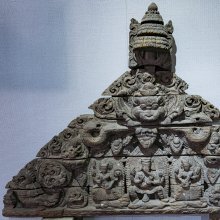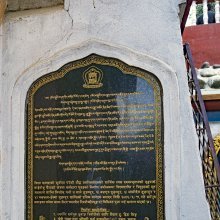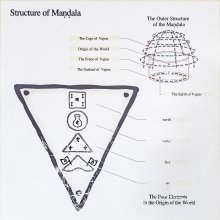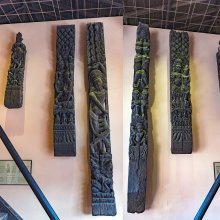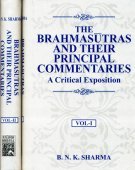Pratika, Prati-ka, Pratīka, Prātikā: 22 definitions
Introduction:
Pratika means something in Hinduism, Sanskrit, the history of ancient India, Marathi, Hindi, biology. If you want to know the exact meaning, history, etymology or English translation of this term then check out the descriptions on this page. Add your comment or reference to a book if you want to contribute to this summary article.
Alternative spellings of this word include Pratik.
Images (photo gallery)
In Hinduism
Pancaratra (worship of Nārāyaṇa)
Source: SriMatham: Vaiṣṇava Iconology based on Pañcarātra Āgamapratīka–Sanskrit term meaning 'symbol' and used in hindu iconology (e.g. the Āgamas).

Pancaratra (पाञ्चरात्र, pāñcarātra) represents a tradition of Hinduism where Narayana is revered and worshipped. Closeley related to Vaishnavism, the Pancaratra literature includes various Agamas and tantras incorporating many Vaishnava philosophies.
Shilpashastra (iconography)
Source: Wisdom Library: Śilpa-śāstraPratīka (प्रतीक) is a Sanskrit word translating to “symbol”. It is used throughout texts and practice of Hindu iconology.

Shilpashastra (शिल्पशास्त्र, śilpaśāstra) represents the ancient Indian science (shastra) of creative arts (shilpa) such as sculpture, iconography and painting. Closely related to Vastushastra (architecture), they often share the same literature.
Ayurveda (science of life)
Source: Wisdom Library: Āyurveda and botanyPratīka (प्रतीक) is another name for Paṭola (Trichosanthes dioica, “pointed gourd”) according to the Bhāvaprakāśa, which is a 16th century medicinal thesaurus authored by Bhāvamiśra. The term is used throughout Ayurvedic literature. Certain plant parts of Paṭola are eaten as vegetables.

Āyurveda (आयुर्वेद, ayurveda) is a branch of Indian science dealing with medicine, herbalism, taxology, anatomy, surgery, alchemy and related topics. Traditional practice of Āyurveda in ancient India dates back to at least the first millenium BC. Literature is commonly written in Sanskrit using various poetic metres.
Purana and Itihasa (epic history)
Source: Wisdom Library: Bhagavata PuranaPratīka (प्रतीक):—Son of Vasu (son of Bhūtajyoti). He had a son named Oghavān. (see Bhāgavata Purāṇa 9.2)
Source: archive.org: Puranic EncyclopediaPratīka (प्रतीक).—Son of a King called Vasu. (9th Skandha, Bhāgavata).
Source: Cologne Digital Sanskrit Dictionaries: The Purana Index1) Pratika (प्रतिक).—The son of Manu and father of Kṛtaratha.*
- * Viṣṇu-purāṇa IV. 5. 27.
2) Pratīka (प्रतीक).—The son of Vasu and father of Oghavan and Oghavatī;1 the Godāvari split herself, out of fear of him.2

The Purana (पुराण, purāṇas) refers to Sanskrit literature preserving ancient India’s vast cultural history, including historical legends, religious ceremonies, various arts and sciences. The eighteen mahapuranas total over 400,000 shlokas (metrical couplets) and date to at least several centuries BCE.
Dharmashastra (religious law)
Source: Sacred Texts: The Grihya Sutras, Part 2 (SBE30)Pratīka (प्रतीक) refers to the first words of a Mantra, as mentioned in the Āpastamba-yajña-paribhāṣā-sūtras.—“Mantras are indicated by their first words”. Commentary: “These first words are often called Pratīkas, and rules are given in Āśvalāyana Śrauta-sūtras I, 1, 17-19, as to the number of words that should form such a pratīka, if it is meant for one verse, for three verses, or for a whole hymn. According to Āśvalāyana, if one foot is quoted, it is meant for a verse; if an imperfect foot of an initial verse is quoted, it is meant for a whole hymn; if more than a foot is quoted, it is meant for three verses”.

Dharmashastra (धर्मशास्त्र, dharmaśāstra) contains the instructions (shastra) regarding religious conduct of livelihood (dharma), ceremonies, jurisprudence (study of law) and more. It is categorized as smriti, an important and authoritative selection of books dealing with the Hindu lifestyle.
India history and geography
Source: Cologne Digital Sanskrit Dictionaries: Indian Epigraphical GlossaryPratika.—cf. Prakrit paḍika (EI 8), see pratikaṃ śatam, ‘one coin per cent’. Note: pratika is defined in the “Indian epigraphical glossary” as it can be found on ancient inscriptions commonly written in Sanskrit, Prakrit or Dravidian languages.

The history of India traces the identification of countries, villages, towns and other regions of India, as well as mythology, zoology, royal dynasties, rulers, tribes, local festivities and traditions and regional languages. Ancient India enjoyed religious freedom and encourages the path of Dharma, a concept common to Buddhism, Hinduism, and Jainism.
Biology (plants and animals)
Source: Google Books: CRC World Dictionary (Regional names)1) Pratika in India is the name of a plant defined with Hibiscus rosa-sinensis in various botanical sources. This page contains potential references in Ayurveda, modern medicine, and other folk traditions or local practices It has the synonym Hibiscus sinensis hort., non Mill. (among others).
2) Pratika is also identified with Trichosanthes cucumerina It has the synonym Trichosanthes cucumerina Buch.-Ham. ex Wall. (etc.).
Example references for further research on medicinal uses or toxicity (see latin names for full list):
· Numer. List (6688)
· J. Cytol. Genet. (1996)
· Journal of the Bombay Natural History Society (1942)
· Journal of Botany, British and Foreign (1939)
· Journal of Cytology and Genetics (1990)
· Vistas in Cytogenetics (1989)
If you are looking for specific details regarding Pratika, for example chemical composition, health benefits, side effects, pregnancy safety, diet and recipes, extract dosage, have a look at these references.

This sections includes definitions from the five kingdoms of living things: Animals, Plants, Fungi, Protists and Monera. It will include both the official binomial nomenclature (scientific names usually in Latin) as well as regional spellings and variants.
Languages of India and abroad
Marathi-English dictionary
Source: DDSA: The Molesworth Marathi and English Dictionarypratīka (प्रतीक).—n (S) A text; the verse, sentence &c. extracted, specified, or quoted in order to be commented on. 2 A point or an item (of a reasoning, deposition &c.) taken up to be disproved. 3 An instance; a case adduced in illustration or comparison.
Source: DDSA: The Aryabhusan school dictionary, Marathi-Englishpratīka (प्रतीक).—n A text. An instance.
Marathi is an Indo-European language having over 70 million native speakers people in (predominantly) Maharashtra India. Marathi, like many other Indo-Aryan languages, evolved from early forms of Prakrit, which itself is a subset of Sanskrit, one of the most ancient languages of the world.
Sanskrit dictionary
Source: DDSA: The practical Sanskrit-English dictionaryPratika (प्रतिक).—a. Worth or bought for a Kārṣāpaṇa, q. v. P.V.1.25 Vārt.2.
--- OR ---
Pratīka (प्रतीक).—a.
1) Directed or turned towards.
2) Inverted, reverse.
3) Contrary, unfavourable, adverse.
-kaḥ 1 A limb, member; अप्राणद्भिः प्राणभाजां प्रतीकैः (aprāṇadbhiḥ prāṇabhājāṃ pratīkaiḥ) Śiśupālavadha 18.79.
2) A part, portion.
-kam 1 An image.
2) Mouth, face.
3) The front (of anything).
4) The first word (of a verse, sentence &c.).
5) A lamp; L. D. B.
6) A symbol.
7) A copy.
--- OR ---
Prātikā (प्रातिका).—The China rose (javā).
--- OR ---
Pratika (प्रतिक).—inverted order.
Derivable forms: pratikam (प्रतिकम्).
Pratika is a Sanskrit compound consisting of the terms prati and ka (क).
Source: Cologne Digital Sanskrit Dictionaries: Shabda-Sagara Sanskrit-English DictionaryPratika (प्रतिक).—mfn.
(-kaḥ-kī-kaṃ) Worth sixteen Pans of Cowries. E. prati substituted for kārṣāpaṇa, and yak aff.
--- OR ---
Pratīka (प्रतीक).—mfn.
(-kaḥ-kā-kaṃ) 1. Contrary, adverse. 2. Inverted, reversed, against the natural order or state. 3. Directed towards. m.
(-kaḥ) 1. A limb, a member. 2. A part, a portion n.
(-kaṃ) 1. the face. 2. The front. 3. An image. 4. The first word of a verse or sentence. E. prati before, ī to go, īkan aff.
--- OR ---
Prātikā (प्रातिका).—f.
(-kā) The China-rose. “javāvṛkṣe” E. pra + ata-ṇvul ṭāp .
Source: Cologne Digital Sanskrit Dictionaries: Benfey Sanskrit-English DictionaryPratīka (प्रतीक).—i. e. pratyañc + a, m. I. adj. 1. Contrary. 2. Inverted. Ii. m. 1. A limb. 2. A part.
Source: Cologne Digital Sanskrit Dictionaries: Cappeller Sanskrit-English DictionaryPratīka (प्रतीक).—[neuter] exterior, surface; face, mouth (poss. vant); look, appearance, image, symbol, copy; (also [masculine]) first verse or word.
Source: Cologne Digital Sanskrit Dictionaries: Monier-Williams Sanskrit-English Dictionary1) Pratika (प्रतिक):—mf(ī)n. ([from] 1. prati) worth a Kārṣāpaṇa or 16 Paṇas of cowries, [Pāṇini 5-1, 25], [vArttika] 2.
2) Pratīka (प्रतीक):—a See p. 675, col. 1.
3) [from praty-añc] b mf(ā)n. (for praty-aka; cf. anūka, apāka, abhīka) turned or directed towards
4) [v.s. ...] (ifc.) looking at, [Bhāgavata-purāṇa]
5) [v.s. ...] ([probably]) going uphill, [Mahābhārata]
6) [v.s. ...] adverse, contrary, inverted, reversed, [cf. Lexicographers, esp. such as amarasiṃha, halāyudha, hemacandra, etc.]
7) [v.s. ...] n. exterior, surface, [Ṛg-veda]
8) [v.s. ...] outward form or shape, look, appearance, face (cf. ghṛta-p, cāru-p, tveṣa-p), [ib.; Nirukta, by Yāska]
9) [v.s. ...] the face ([especially] the mouth), [Ṛg-veda; Śatapatha-brāhmaṇa; Pāraskara-gṛhya-sūtra]
10) [v.s. ...] the front, [Monier-Williams’ Sanskrit-English Dictionary]
11) [v.s. ...] an image, symbol, [Chāndogya-upaniṣad [Scholiast or Commentator]]
12) [v.s. ...] a copy, [Vāmana’s Kāvyālaṃkāravṛtti]
13) [v.s. ...] n. (also m.) the first part (of a verse), first word, [Brāhmaṇa] etc. etc.
14) [v.s. ...] m. a part, portion, limb, member, [cf. Lexicographers, esp. such as amarasiṃha, halāyudha, hemacandra, etc.] (cf. prati-pr, p. 662, col. 2)
15) [v.s. ...] Name of a son of Vasu and father of Ogha-vat, [Bhāgavata-purāṇa]
16) [v.s. ...] of a son of Maru, [Viṣṇu-purāṇa]
17) Prātikā (प्रातिका):—f. the China rose, Hibiscus Rosa Sinensis, [cf. Lexicographers, esp. such as amarasiṃha, halāyudha, hemacandra, etc.]
Source: Cologne Digital Sanskrit Dictionaries: Yates Sanskrit-English Dictionary1) Pratika (प्रतिक):—[(kaḥ-kī-kaṃ) a.] Worth sixteen pans of Cowries.
2) Pratīka (प्रतीक):—[(kaḥ-kā-kaṃ) a.] Contrary, inverted. m. A limb; a part.
3) Prātikā (प्रातिका):—(kā) 1. f. Decrepitude.
Source: DDSA: Paia-sadda-mahannavo; a comprehensive Prakrit Hindi dictionary (S)Pratīka (प्रतीक) in the Sanskrit language is related to the Prakrit word: Paīa.
[Sanskrit to German]
Sanskrit, also spelled संस्कृतम् (saṃskṛtam), is an ancient language of India commonly seen as the grandmother of the Indo-European language family (even English!). Closely allied with Prakrit and Pali, Sanskrit is more exhaustive in both grammar and terms and has the most extensive collection of literature in the world, greatly surpassing its sister-languages Greek and Latin.
Hindi dictionary
Source: DDSA: A practical Hindi-English dictionaryPratīka (प्रतीक) [Also spelled pratik]:—(nm) a symbol; fetish; -[prayoga] symbology; symbolism; symbolization; ~[vāda/~vāditā] symbolism; ~[vādī] a symbolist; symbolical; -[vidyā] symbolics; symbology; -[vidhāna] symbology, symbolization.
...
Kannada-English dictionary
Source: Alar: Kannada-English corpusPratīka (ಪ್ರತೀಕ):—
1) [adjective] unfavourable; adverse; hostile; unfriendly.
2) [adjective] reversed; turned backward or upside down.
--- OR ---
Pratīka (ಪ್ರತೀಕ):—
1) [noun] a part, portion of a whole.
2) [noun] any part of the body.
3) [noun] an indication, token or sign.
4) [noun] an image or reproduction of an object.
5) [noun] a thing that represents or symbolises another thing, thought or principle.
6) [noun] the shape, outline or configuration of anything; structure as apart from colour, material, etc.; form.
Kannada is a Dravidian language (as opposed to the Indo-European language family) mainly spoken in the southwestern region of India.
See also (Relevant definitions)
Starts with (+59): Pratikacihna, Pratikadarshana, Pratikakamin, Pratikakatha, Pratikakshi, Pratikalam, Pratikalambana, Pratikalpa, Pratikalpam, Pratikalpya, Pratikama, Pratikamam, Pratikamgollu, Pratikami, Pratikamin, Pratikamini, Pratikamkshanata, Pratikamp, Pratikamya, Pratikanchuka.
Ends with (+1): Adhyardhapratika, Apratika, Asampratika, Carupratika, Dushpratika, Dvipratika, Ghritapratika, Madhupratika, Pratipratika, Purudhapratika, Sampratika, Saupratika, Sayampratika, Shucipratika, Simhapratika, Somapratika, Supratika, Taittiriyapratika, Tveshapratika, Vyaghrapratika.
Full-text (+40): Pratikya, Supratika, Somapratika, Pratikadarshana, Pratipratikam, Pratikashva, Paia, Pratikavat, Pratikatva, Adhyardhapratika, Pratikarkasha, Kritaratha, Dvi, Dvipratika, Yina-yanako-pratika, Shucipratika, Oghavati, Simhapratika, Carupratika, Purudhapratika.
Relevant text
Search found 44 books and stories containing Pratika, Prati-ka, Pratiika, Pratiīka, Pratīka, Prātikā; (plurals include: Pratikas, kas, Pratiikas, Pratiīkas, Pratīkas, Prātikās). You can also click to the full overview containing English textual excerpts. Below are direct links for the most relevant articles:
Rig Veda (translation and commentary) (by H. H. Wilson)
Brihad Bhagavatamrita (commentary) (by Śrī Śrīmad Bhaktivedānta Nārāyana Gosvāmī Mahārāja)
Verse 2.2.49 < [Chapter 2 - Jñāna (knowledge)]
Apastamba Yajna-paribhasa-sutras (by Hermann Oldenberg)
Brahma Sutras (Ramanuja) (by George Thibaut)
Sutra 4.1.4 < [Fourth Adhyaya, First Pada]
Prashna Upanishad with Shankara’s Commentary (by S. Sitarama Sastri)
Verse 5.5 < [Prashna V - Meditation on the syllable ‘Om’]
Verse 5.2 < [Prashna V - Meditation on the syllable ‘Om’]
Katha Upanishad with Shankara’s Commentary (by S. Sitarama Sastri)
Verse 1.2.15 < [Adyaya I, Valli II - The pursuit of Knowledge and Yoga]
Related products
